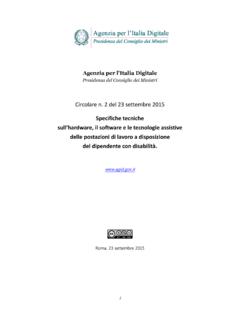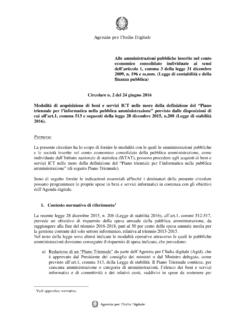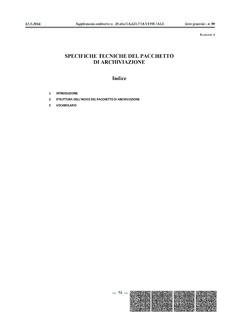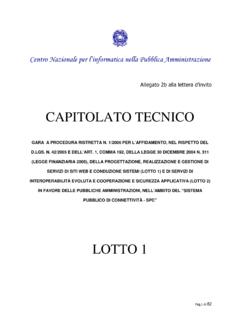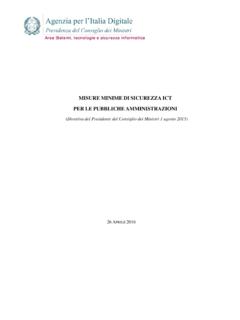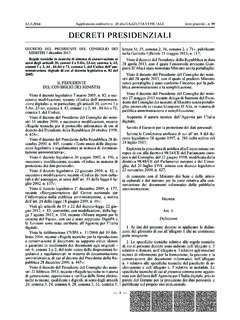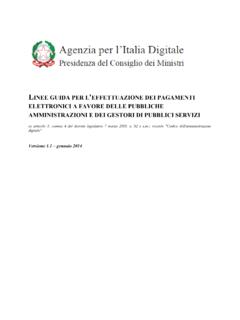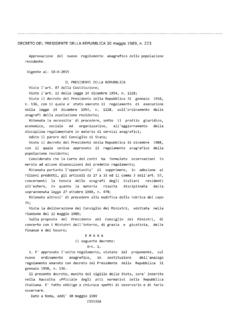Transcription of The Italian strategy for next generation access …
1 The Italian strategy for next generation access network Presidenza del Consiglio dei Ministri Introduction 4 Brief summary 10 Division into four clusters 11 Auction on time 11 Accompanying the migration 12 1. Within the context of the strategic plan 14 The infrastructure is not technology 20 "Future proof" Infrastructure 23 2. strategy for ultra-fast broadband 45 An integrated and synergic approach between fixed and mobile access .
2 49 Towards the second goal of the European Digital Agenda 52 Towards the third goal of the European Digital Agenda 53 EU Constraints: What is not possible to do 58 The tools of the Plan 58 Models for infrastructure deployment 61 Model I - Direct intervention 63 Model II - Public Private Partnership 65 Model III - Incentive model 66 Model IV - Intervention for demand aggregation 67 Incentives to lower economic barriers to entry 70 Facilities for access to economic resources 77 Demand stimulation 83 Annex A- Enabling
3 Technologies for Ultra Fast Broadband services. 103 Technologies enabling the provision of 30 and 100 Mbps connectivity services to end-users. 104 The role of Radio technologies 105 Wired technologies 108 Choices of the telecommunications operators in Italy 112 Technological scenarios 116 Annex B - The demand for broadband and ultra broadband services 119 The delay in Italy 120 People s demand 122 Companies and institutions demand 128 Annex C - Guidelines.
4 National Federated Information System of Above and below ground utilities 134 Reasons of a choice 135 National Framework 136 National strategy for the spread of Ultra Wide Band 139 EU Directives 140 The national information system of the state above and underground 142 Actors and the roles of competence 143 Functional requirements and architecture of reference 146 Possible infrastructure to be surveyed 149 Minimum information and access policies 149 Regulatory issues 150 Time and costs 152 Summary of Objectives 154 !
5 3 THE Italian strategy FOR NEXT generation access NETWORKI ntroduction Telecommunication networks have become the nervous system of any modern nation. A nation does not stop if you stop the transport system. Does not stop even for a general strike. But if telecommunication networks would stop - it never happened, very few activities would not be able to stop. In perspective, and it s a perspective that is moving ever faster, telecommunication networks will be even more important. Not only will connect millions of people, but also tens of millions of computers and billions of objects (Internet of Things). The cyber war, which until recently was just a subject for political fiction books, fiction or espionage, is now a reality. To destroy the reputation of a company what could be more simple than to hack their information systems? How long will it take before entire states are being targeted? We should start thinking now the infrastructure on which to build our future.
6 In the past Italy has come late to large infrastructure choices, making short-sighted decisions. It was so on the third lane of !4 THE Italian strategy FOR NEXT generation access NETWORK motorways, high-speed trains, for large airports and for the fiber networks. High speed Internet infrastructure and services will be the raw material of our future, for the entire economic and social environment. It will be the essential resource on which to build the future competitiveness of the country and on which we will measure our ability to remain one of the most advanced nations of the planet. Some, confusing infrastructure choices with technological ones, prefer to wait: as technology changes all the time, that of tomorrow will be better than today. But infrastructure is the "physical" mean that carries information. Can be the either, a copper twisted pair, a coaxial cable or an optical fiber. The technology, however, is what makes it possible to transmit information through infrastructure.
7 ISDN, ADSL, ADSL2, ADSL2 +, , GSM, LTE, LTE Advanced are all acronyms that define technologies. Technology evolves continuously, the infrastructure remains and does not change when technology changes. Technological choices can also be opportunistic, because they have less constraints compared to infrastructural ones and are easier to edit. Infrastructure choices, however, affect technological choices because they decide what the future may offer and, ultimately, what will be our future. The development of infrastructure is easily predictable but to change infrastructure choices is difficult, expensive and involves sunk costs that one day could be defined as misspend. It is already clear that fixed networks will always offer better performances compared to wireless networks, and that optical infrastructure will always be capable of delivering broadband access services with enhanced characteristics as compared to existing basic broadband networks.
8 !5 THE Italian strategy FOR NEXT generation access NETWORKS imilarly, it is already equally clear that the majority of users, unless they are public administrations or businesses, prefer to communicate through mobile connections, free from the constraints of physical proximity. But performance of mobile networks will be more and more influenced by backhauling infrastructure on which they rely on: whether wireless (themselves) or fixed, if copper or fiber and how dense cell grids are to serve their users. Having in mind this, the strategy set out in this document defines the framework within which public administrators, private operators and all stakeholders will be able to exercise the difficult art of discernment in the design of a future-proof telecommunication infrastructure, looking for the right balance between investments and benefits to the users of the various local communities, between technological flexibility and capacity-intensive technology demand.
9 But, ultimately, these will be the real infrastructure choices. Someone, understandably skeptical might wonder: but are high speed broadband information highways really needed if today there are just few applications that can take advantage of the 100 Mbps speeds that they provide? Metaphors sometimes deceive. "Information highways", both mobile and fixed ones, rather than being quick, guarantee "safer" performances. They are defined "high speed ", but in reality they are "capacity-intensive": it s like a 100 lane road where it is very difficult to find a traffic jam, and for this reason information travels quicker. This is why South Korea is already updating its network bringing it from speeds of 100 Mbps to up to 1 gigabits per second. Similarly, in the USA, since 2010 the government has set itself the goal of connecting all the premises of the public administrations with speeds of at least a 1 gigabits per second by 2020 and today, in !6 THE Italian strategy FOR NEXT generation access NETWORK entire metropolitan areas as well as in many local communities, national and regional operators are building networks with speeds of up to 1 gigabit per second and presenting the first commercial offers for businesses with speeds of up to 10 gigabits per second.
10 Equally, in Israel, Slovenia, Romania, South Africa, UK and in many other parts of the world, where there are optical networks already supporting speeds of 100 Mbit/s, they are investing to make a quantum leap towards networks supporting speeds of up to 1 gigabits per second, because existing ones soon will prove unsatisfactory. Italy is back in all the European charts for take up of advanced digital services and last for high speed networks availability. This is an alarming fact because it can be the source of other - and increasingly large - gaps that will be difficult to fill if they develop further. To provide Italy with high speed networks is an indispensable condition, one day, to have a faster, more agile, less bureaucratic Italy. For this reason, the strategy for high-speed Internet infrastructure and services is not the answer to the nth request that comes from the European Union. On the contrary, it is the first step of a larger project that incorporates the objectives of the European Digital Agenda, but goes further.
